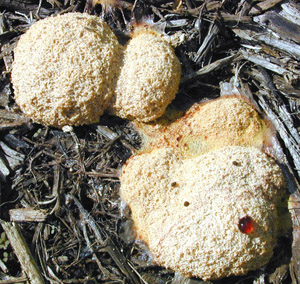 username@email.com
username@email.com
In this lesson, you will review the characteristics and types of molds.
The last, and surely the strangest, group in the Kingdom Protista is the slimemolds. Some taxonomists place the slime molds in their own subkingdom of fungi, and sometimes call them lower fungi. Taxonomists who classify them with protists point out their close connections to amoebas.
Despite their nomenclatural handicap, slime molds are fascinating organisms. There are two distinctly different, and perhaps totally unrelated, types of slime molds.
Acellular slime molds (Division Myxomycota) create a slimy mass called a plasmodium, akin to a monstrous amoeba, that slithers slowly over moist areas in forests. The plasmodium may contain pigments, likely used as photoreceptors that give them a beautiful color. Acellular slime molds use phagocytosis to feed on bacteria, spores, and bits of decayed organic matter. The plasmodium is actually a cell-like organism containing many nuclei, which result from numerous mitotic divisions. Acellular slime molds spend their nonreproductive lives as creeping protoplasm that continues to grow (up to 50 gm) as long as there is food to eat. When times are tough, the plasmodium breaks up into globs of protoplasm. Each globule develops into a sporangium perched atop an elongated stalk. Then meiosis occurs and produces haploid spores. The spores go airborne until they land in a new, suitable site, where each will divide and, after several intermediate forms, becomes a new plasmodium.

Slime Mold
Cellular slime molds (Division Acrasiomycota) are not plasmodium; instead, as cells, they exist as free-living amoebas in damp environments. When conditions dry out, or when food becomes scarce, these slime molds emit a pheromone called cyclic AMP, or cAMP. The call of cAMP is irresistible and causes hordes of ameboid slime molds to congregate into a pile. It is then that truly bizarre things happen. Together, these once-independent cells form a primitive type of multicellular organism with specialized cells. In its first incarnation, this organism becomes a slug, actually moving around like a slug. Soon, a fruiting body, made up of some of its amoeboid components, is extruded by the slug. A few of these cells are then transformed into spores. A sexual cycle fuses two haploid spores, which can then develop into more cellular slime molds.
Both Divisions of slime molds share
The correct answer is C. Both types of slime mold reproduce with spores. Only cellular slime molds produce cAMP, so A is incorrect. Only acellular slime molds contain many nuclei, so B is not correct. Only cellular slime molds congregate to form a multicellular organism, so D is not correct.